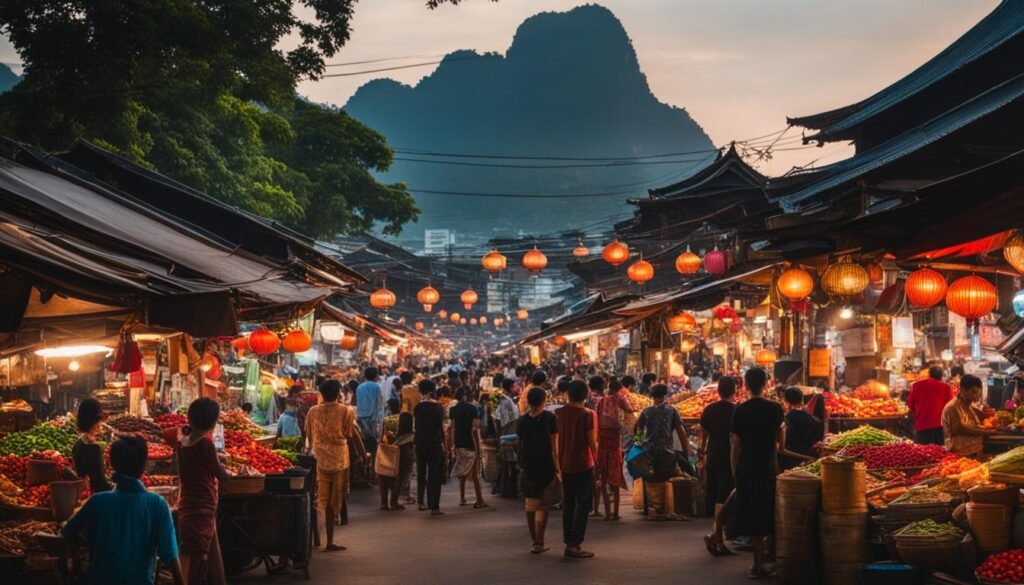
You might find yourself mesmerized by vibrant patterns and textures, yet unaware of their origins. Southeast Asian textiles tell a tale as richly intricate as the designs themselves, embodying both cultural symbolism and masterful artisanship.
This article unfolds these woven histories, guiding you to appreciate every thread’s story in the fabric of time. Discover a world interlaced with heritage.
Key Takeaways
- Southeast Asian textiles are full of stories and symbols. They show where people come from and what they believe.
- Weavers use techniques like ikat and loom weaving to make clothes with deep cultural meanings.
- Museums, experts, and weavers work together to save these textile traditions. Exhibitions teach more people about this important art.
- Traveling to Southeast Asia lets you see how old ways of making textiles mix with new styles today.
The Historical Significance of Textiles in Southeast Asia

Dive into the tapestry of Southeast Asian history where textiles are far more than mere fabric; they serve as a vibrant lexicon of cultural expression and social identity. Unravel the threads where every pattern and hue narrates ancestral tales, embodying the region’s deep-rooted values and communal bonds.
Cultural symbolism and communication
Clothes and textiles in Southeast Asia tell stories. They are more than just things to wear or use to decorate. Each pattern, color, and thread can show where a person comes from, their social status, or what they believe in.
In places like Indonesia or Thailand, the designs woven into clothes have special meanings that have been passed down through many years.
Weavers put their hearts into making these textiles. Their skill turns simple threads into powerful symbols. A single piece of fabric can communicate respect for ancestors or celebrate big life events like weddings or festivals.
By wearing these traditional clothes, people keep their histories alive and share them with the world without saying a word.
The artistry and skill of traditional weavers
Beyond the symbols and messages encoded in their patterns, Southeast Asian textiles are a testament to the incredible artistry of local weavers. These skilled artisans have spent generations perfecting handwoven textiles that astonish with intricate designs and vibrant colors.
Each piece they create is more than just fabric; it’s a canvas where traditional craftsmanship merges with artistic expression.
These weavers work magic with threads, combining color and texture to tell stories of their culture and history. As your fingers trace the contours of a woven masterpiece, you can almost hear the whispers of ancient tales from ethnic weaving traditions handed down through time.
Their talent captures not only beauty but also a deep sense of cultural heritage that is sewn into every strand.
The Weaving Techniques of Southeast Asia

Dive into the intricate world of Southeast Asian weaving, where every thread intertwines with age-old stories and cultural expressions. Explore unique methods passed down through generations that have not only fashioned fabric but also woven the very identity of this vibrant region.
The warp ikat technique
The warp ikat technique is a special way people in Southeast Asia make beautiful cloth. They start by tying and dyeing the threads before they weave them together. This makes exciting patterns that are hard to find anywhere else.
Imagine painting a picture with thread, each piece carefully dyed to create an amazing design when woven.
In places like southern Sumatra, weavers use this technique on both the long threads (the warp) and the crosswise threads (the weft). The result? A cloth where every inch tells a story of tradition and skill passed down through many years.
Next, let’s discover loom weaving and its different kinds across Southeast Asia.
Loom weaving and its various forms
Loom weaving is a key part of Southeast Asian textile tradition. It showcases the incredible skill and creativity of women weavers in the region.
- Backstrap loom: This simple loom is tied around the weaver’s back and attached to a stationary object. It’s portable and allows for tight tension on the threads, which helps create intricate designs. In Southeast Asia, you’ll find women using backstrap looms to weave beautiful supplementary weft and warp patterns.
- Foot-treadle loom: A more complex type of loom that uses pedals, called treadles, to control the warp threads. This lets the weaver use both hands to pass the weft threads through. These looms can create wider pieces of fabric faster than backstrap looms.
- Horizontal frame loom: This type of loom has a frame that holds all the threads tight. Weavers in Southeast Asia use it to produce large textiles like blankets and ceremonial cloths.
- Warp ikat technique: Before weaving starts, threads are tie-dyed in specific patterns. When these dyed warp threads are woven with plain weft threads, they create an amazing pattern that looks as if it’s been painted on.
- Supplementary weft technique: Extra weft threads are added in as the cloth is woven to make detailed pictures or designs on top of the basic weave structure.
The Evolution of Textile Traditions
The tapestry of Southeast Asian textile traditions is not merely a reflection of its past but also an evolving canvas, adapting to the threads of modernism while retaining the essence of ancient motifs.
Witness how these vibrant art forms have deftly navigated the loom of time, interlacing traditional methods with contemporary demands to fashion a narrative as dynamic and resilient as the fabrics themselves.
Influence of neolithic cultures
Long ago, people in what we now call Southeast Asia learned to make clothes from ancient cultures all over the Asian mainland. These old ways of making textiles have a lot to do with how people make them in Southeast Asia today.
Scientists digging up old places found tools like spindle whorls. They showed that even back then, people knew how to spin threads and weave them into cloth.
People used these skills to create beautiful patterns and designs on their textiles. Even now, you can see the mark of neolithic societies on modern fabrics. The ways they made cloth back then shaped how it’s done now across countries like Thailand, Indonesia, and Vietnam.
Next, let’s explore how these traditions changed as they mixed with new ideas over time.
Adaptations to modern life and fashion
As time moves on, Southeast Asian textiles have also changed. Modern life and fashion have brought new styles and needs. People in the textile industry mix old patterns with new trends.
They keep the beauty of their past but make it fit today’s world.
Designers take ancient symbols and use them in clothes that people wear every day. These pieces tell a story and connect us to the land’s history. Some use modern machines to make things faster, but they still respect the skill of hand weaving.
Others focus on making clothes that don’t harm our earth, which is called sustainable fashion. They all work hard to keep their traditions alive in a changing world.
Visiting Southeast Asia’s Cultural Heritage Sites: A Journey Through Textile History
Travel to Southeast Asia’s cultural heritage sites and you’ll find a world rich with textile history. Each thread tells a story of tradition and skill passed down through generations.
You can see the vivid colors and patterns of batik in Indonesia, where artists draw intricate designs on cloth with wax before dyeing it. Go to Vietnam, and you might watch weavers turn silk into beautiful fabrics using looms that have been around for centuries.
These places mingle old ways with new styles. They show how ancient weaving techniques still live in modern clothes and decorations. Your journey through these sites will not only teach you about textiles but also about the people who make them.
At each stop, expect to be amazed by the countless styles, techniques, and ornaments that create Southeast Asia’s fabric landscape.
As you learn more about preserving this unique art form, your appreciation for their beauty will grow even deeper.
Preserving the Textile Heritage
As Southeast Asia’s textile tapestry unfurls through the ages, there is a burgeoning movement afoot to safeguard these vibrant strands of history. Museums partner with artisans, while community initiatives breathe new life into ancient looms, ensuring that each thread of this rich heritage continues to tell its story for generations to come.
Efforts in documenting and conserving textile art
Southeast Asian textiles are more than just cloth. They hold stories, traditions, and a heritage that needs saving. Here’s how people are working hard to keep these treasures alive for future generations:
- Experts travel across Southeast Asia to find old textiles. They take photos and write about each piece’s story and how it was made.
- Museums like the Asian Art Museum of San Francisco show off these fabrics in exhibitions such as “Weaving Stories.” This lets more people see and learn about them.
- Weavers who know old ways pass down their skills. They teach others so these techniques don’t get lost.
- Some groups write books and make videos about textile art. This helps share knowledge all over the world.
- People also look back at how Southeast Asians have saved textiles in the past. This helps them think of new ways to protect these beautiful works.
- Many try to get Southeast Asian textiles named as heritage objects. Being on this list means they’re super important and deserve care.
Educational exhibitions and cultural programs
Documenting and conserving textile art is just the first step. Next, educating people and sharing these traditions keep the stories alive. Educational exhibitions and cultural programs have a special part in this.
- They display beautiful Southeast Asian textiles for everyone to see. This way, more people learn about the rich weaving history.
- These programs often include talks by experts. They share exciting stories and facts about the textiles.
- Museums like the Asian Art Museum of San Francisco put on shows like “Weaving Stories.” This helps to tell about Southeast Asia’s colorful history through cloth.
- Many schools and communities hold classes or workshops. Here, you can learn to weave and understand the tradition.
- Some programs work to protect old ways of making textiles. But they also find new ways to keep them important today.
- Events bring together weavers and artists from across Southeast Asia. They meet, learn from each other, and show off their skills.
- Through these activities, people can see why it’s important to keep these traditions safe.
- Cultural programs create a love for Southeast Asian history in new places all over the world.
Conclusion
You’ve just explored the deep and colorful world of Southeast Asian textiles. Each thread and pattern tells a story, celebrates tradition, and shows off amazing skills. From clothes worn every day to beautiful art hung on walls, these fabrics touch all parts of life in Southeast Asia.
Remember how rich history weaves into modern style as you see these textiles in the world around you. Let’s cherish this heritage and keep the stories in these stunning woven histories alive for years to come.
For an in-depth exploration of these intricate art forms and the places they come from, embark on “A Journey Through Textile History” at Thailand’s most revered cultural heritage sites.
FAQs
1. What are Southeast Asian textiles?
Southeast Asian textiles are cloths made in countries like Thailand, Vietnam, and Laos with unique designs and colors.
2. How are these textiles made?
These textiles are often woven by hand on looms, a tool that helps make the fabric.
3. Why are Southeast Asian textiles special?
They’re special because they have beautiful patterns that tell stories about the culture and history of the people who make them.
4. Can I wear Southeast Asian textiles?
Yes, you can wear them! They’re used to make clothes, scarves, and bags that look great.
5. Where do people find Southeast Asian textiles?
People find them in markets or shops in Southeast Asia and sometimes at international stores that sell items from around the world.


